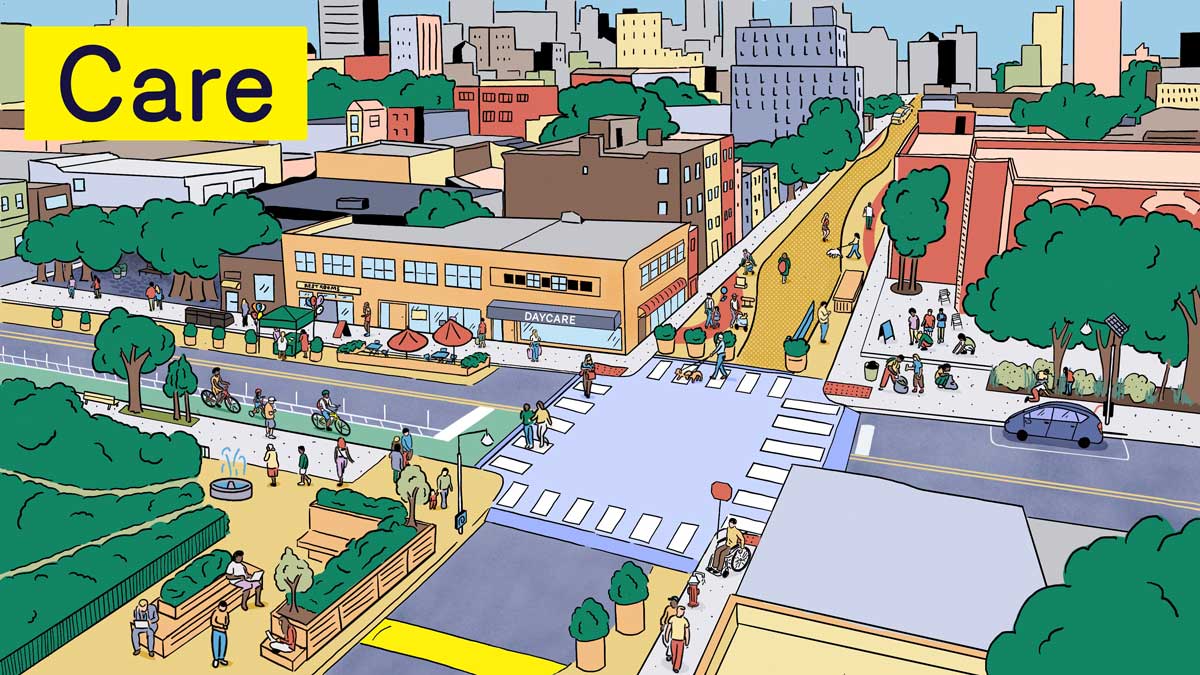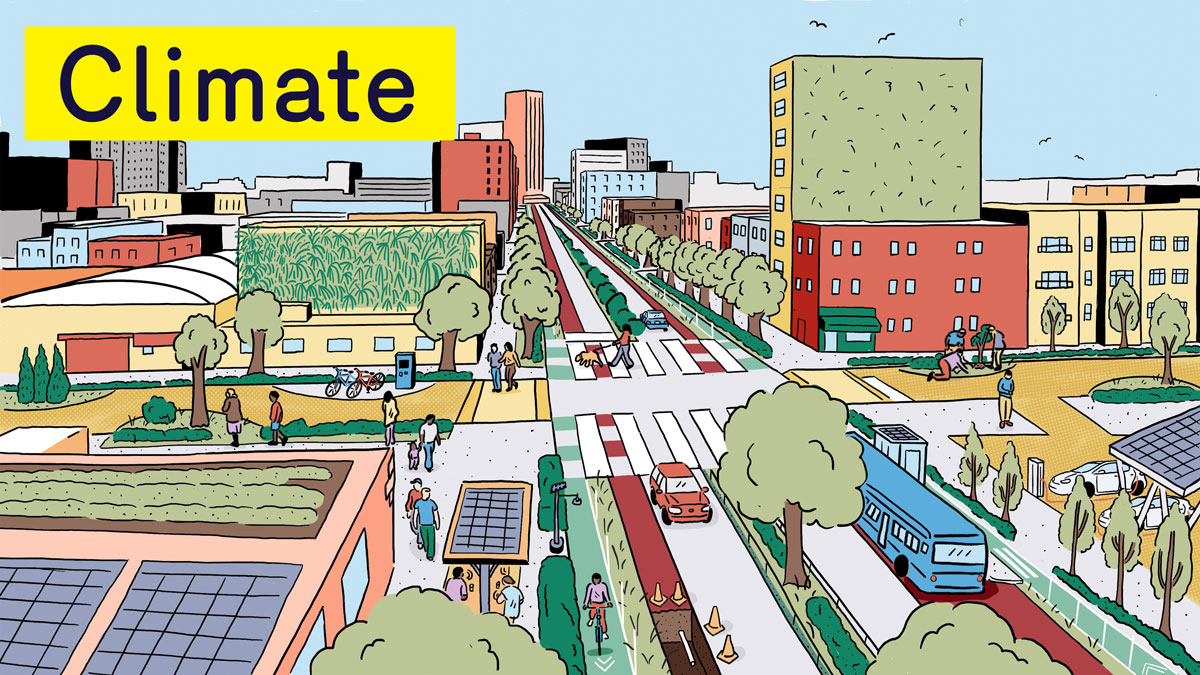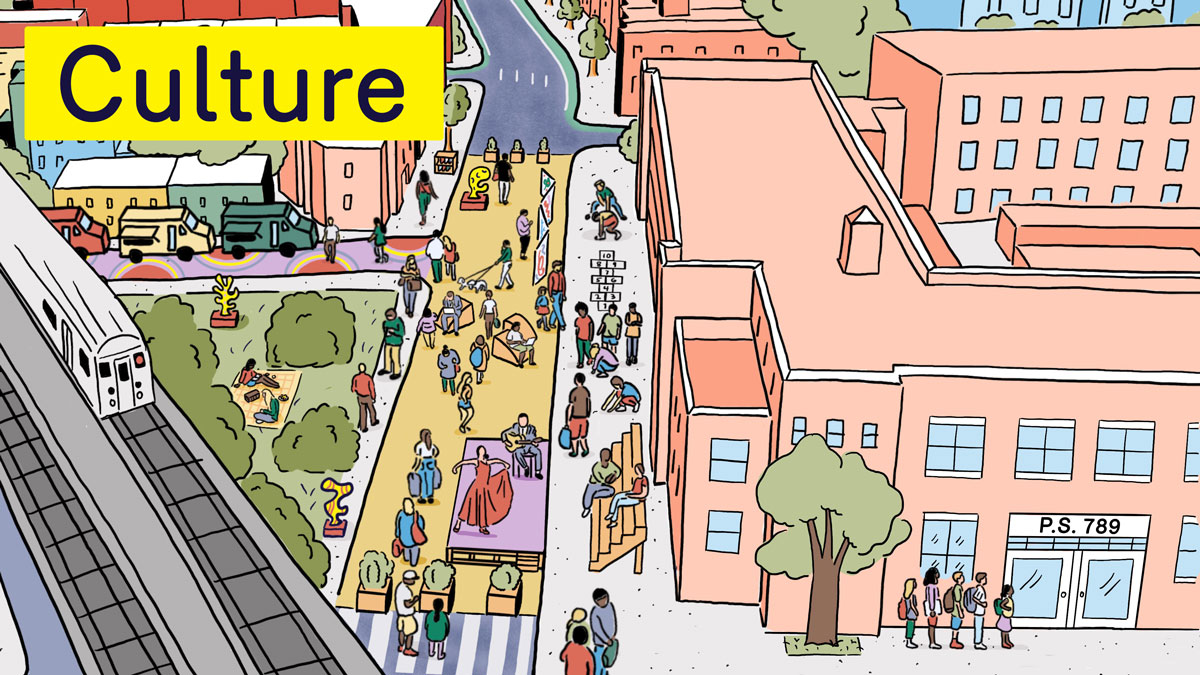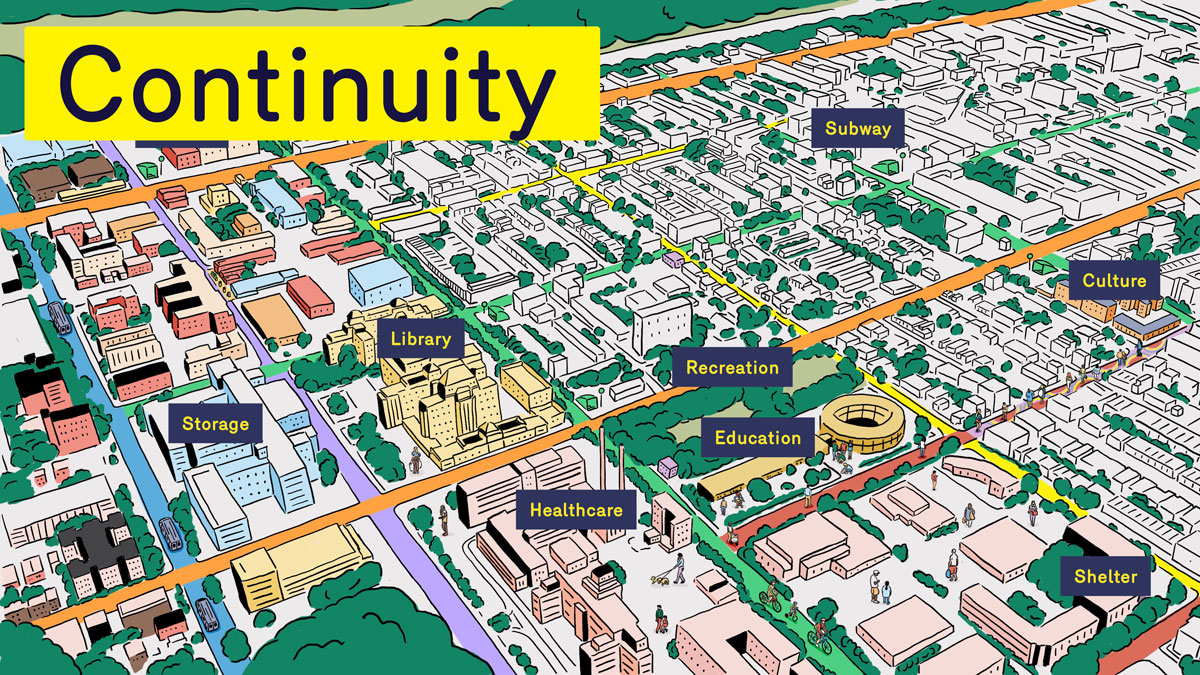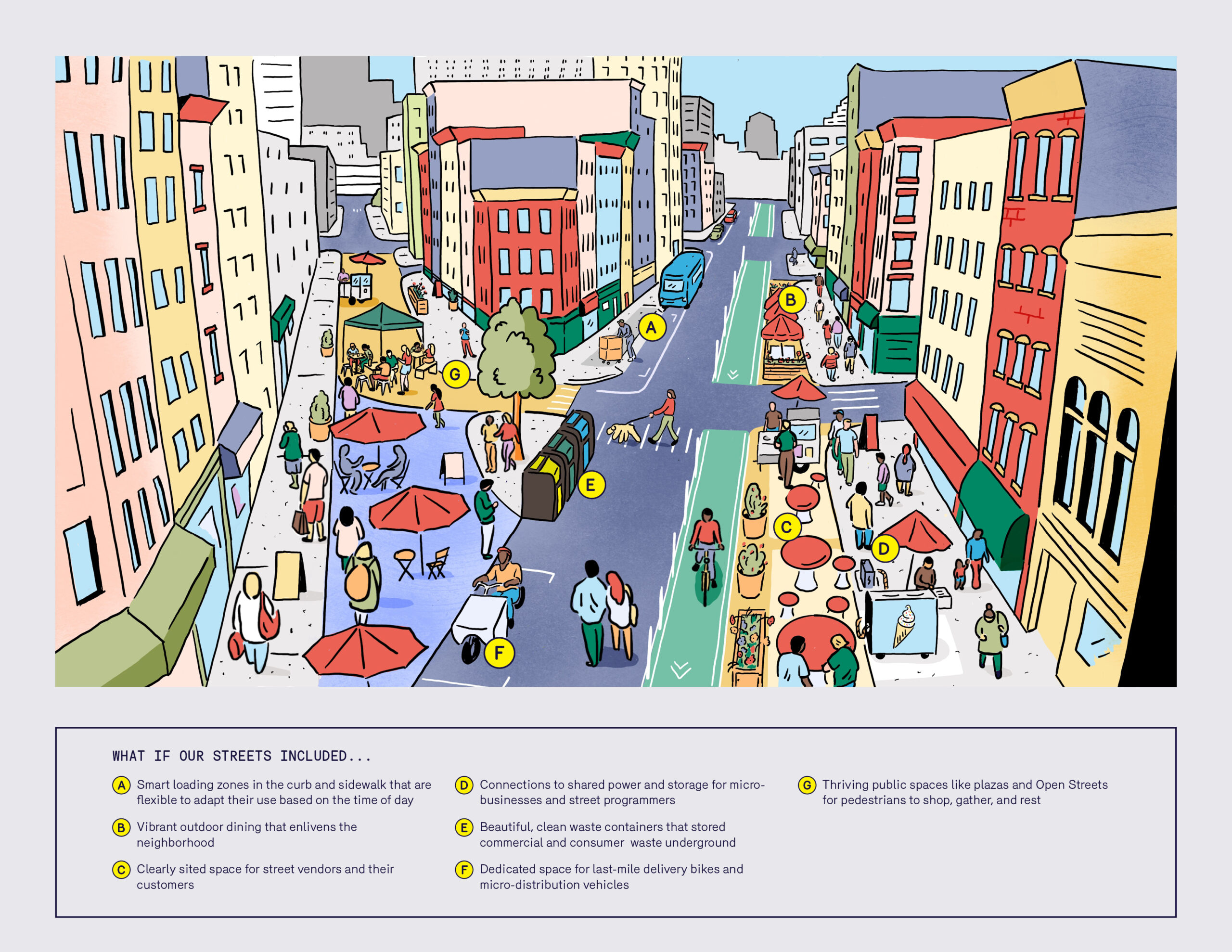
The Vision
Commercial corridors are the economic engines of our neighborhoods. From the bodega to the bookstore, these spaces are vital to the health and vibrancy of our city and street life.
Our commercial corridors were hit hard by the COVID-19 pandemic; New York lost almost 170,000 jobs in restaurants and retail, 41% of the total private sector jobs lost since 2019 [1]. In immigrant-owned businesses and MWBEs that were disproportionately impacted, we now see record retail vacancy. Outdoor dining and the Open Storefronts program emerged as design solutions early on for some businesses, but left many other entrepreneurs without creative means for commerce.
As small businesses try to regain their footing today, they face many other spatial challenges unrelated to the pandemic. The rise in e-commerce has fundamentally reshaped the role of the street, threatening brick-and-mortar retail and flooding neighborhoods with delivery trucks. Shifting commuting patterns due to the rise of working from home will continue to impact the city’s core office districts and the small businesses commuters would patronize on a daily basis.
We envision Commercial Streets that are bustling, adaptable, welcoming, accessible places that help to build community wealth and promote a prosperous environment for businesses of all sizes, especially the mom-and-pops. Our vision for achieving commercially thriving New York City streets is one that prioritizes equity for small businesses and businesses run by Black and brown New Yorkers. To do this, we believe citywide changes to streets should make it easy to do business by cutting through the red tape, while local changes can amplify the defining characteristics of New York’s distinct neighborhoods that attract both new and old patrons.
Recommendations
The flow of raw materials and goods into and out of the city is a logistically complicated network of dedicated truck routes and local car traffic that often clashes with the daily movement of pedestrians and cyclists, and is a significant producer of emissions. Spaces for the staging of goods, materials, and waste are limited or shared with other uses.
1. Institute first mile waste collection and subsurface storage.
Building on the new framework for the Commercial Waste Zones Plan laid out by the NYC Department of Sanitation (DSNY), the City could build out a network for retail waste to be collected by smaller transport vehicles (e.g. gator cart or small flatbed electric vehicles) on a frequent basis. Commercial waste could be taken to a nearby transfer point where it is carted away to a larger vehicle for removal to a landfill. Larger cost and site feasibility studies for subsurface storage should be undertaken.
ACT NOW: Pilot on-street shared waste containers.
DSNY and the NYC Department of Transportation (DOT) could partner to expand the Clean Curbs pilot program to include using street space for innovative waste containerization. Explore on-street containers with subsurface storage as consolidated drop points for retail waste to be serviced by carting trucks. Heavily subsidize participation in Clean Curbs by offering city funding for both community partners and hauling partners.
2. Expand flexible loading zones into every neighborhood.
On-street consolidated delivery and loading zones for homes and businesses can better manage the current chaos of curbside deliveries. By 2030, the City could build on the NYC City Council’s December 2021 law to implement 500 new dedicated loading zones across the city each year for the next three years, and consider expanding the initiative to all commercial corridors that need it. Flexible loading zones (indicated by sensors or with changing indicators) could accommodate off-hour delivery in the early morning and late evening hours, and act as public space during the daytime.
ACT NOW: Invest in commercial cargo bike infrastructure.
Cargo bikes have proven to be an effective method of reducing the number of delivery trucks on the road. Expand and make permanent the Commercial Cargo Bicycle Pilot by DOT, allocating curb space for cargo bike loading.
3. Activate micro-distribution centers in each borough.
By 2030, DOT could develop a pilot program for micro-distribution centers in every borough, where delivery trucks unload at distribution point(s) at neighborhood peripheries and transfer to smaller, local delivery vehicles. DOT, New York State DOT, and NYC Department of Citywide Administrative Services (DCAS) could lead a feasibility study to identify city-owned real estate that align with existing truck routes.
ACT NOW: Transform vacant storefronts for temporary micro-distribution needs.
In 2023, the NYC Department of City Planning (DCP) and NYC Economic Development Corporation (EDC) could pilot a program with real estate developers or private micro-distribution logistics companies to transform vacant retail or other under-utilized ground-floor space to act as micro-distribution hubs, where delivery companies could pay to use space. Design standards should be developed to ensure these spaces have active and engaging storefronts and ensure pedestrian accessibility, and a study should be undertaken to understand impacts on the health of brick and mortar businesses.
4. Create hubs for shared connectivity and power on the streets.
As visitors traverse the city, businesses often bear the burden of serving as the de facto resource for public services like restrooms, seating, and shelter during inclement weather. By 2030, DOT could pilot and build out shared amenities hubs across all commercial districts and corridors for local and visiting patrons with services like charging stations, drinking water, bathrooms, and wifi.
ACT NOW: Pilot a neighborhood shared service hub.
DOT and NYC Department of Small Business Services (SBS) could partner to lead a design competition to pilot neighborhood shared service hubs that provide onsite equipment storage for micro-businesses, storefronts and community organizations for items like traffic cones, snow shovels, seating, or programming materials for Open Streets.
5. Update the Street Design Manual to include the relationship between storefronts and the streets.
In light of increasing logistics challenges, DOT and SBS could add to the existing Street Design Manual to include neighborhood design guidelines and a kit-of-parts that address the relationship between storefront businesses and the street.
ACT NOW: Assign a task force to address storefront businesses.
In 2023, the Interagency Public Realm Working Group, should investigate immediate opportunities to clarify street space use for storefront businesses.
6. Expand and equip our underinvested and outer borough business improvement districts and community-based neighborhood maintenance partners.
Building on the Mayor’s plan in Rebuild, Renew, Reinvent to launch a BID 2.0 model, the City could prioritize fully funding existing smaller outer borough BIDs in outer boroughs and support the easy creation and public funding of new BIDs to provide better management of public streetscapes and plazas in historically underinvested neighborhoods. The City could fund and embed a designer or planner in every existing under-resourced BID to equip them with the expertise to oversee capital grants and projects.
ACT NOW: Create a Street Innovation Fund.
In 2023, the Office of the Deputy Mayor for Economic and Workforce Development and SBS could create a dedicated fund for BIDs with operating budgets of less than $500,000 to incentivize innovative street and public space design and programming.
ACT NOW: Expand SBS’s Neighborhood 360° Program.
Expand SBS’s Neighborhood 360° Program and explore the creation of neighborhood-based conservancies that could equip hardest-hit communities with additional small businesses and public realm support.
7. Launch a Citywide Equity BID
The current model for BIDs prioritizes neighborhoods with greater access to private investment. By 2030, the City could establish a citywide fund to resource neighborhoods without BIDs with public space maintenance funds.
ACT NOW: Launch a public space funding audit.
In 2023, the Interagency Public Realm Working Group, announced in Rebuild, Renew, Reinvent, could launch a study to better understand gaps and opportunities in public space maintenance funds across the city, to inform the launch of a Citywide Equity BID.
8. Develop a comprehensive framework for street vendors.
Street vendors are an essential part of a neighborhood’s economy, yet are often not considered when designing our city’s streets. The NYC Department of Consumer and Worker Protection (DCWP), in partnership with SBS, DOT, and others, could develop a policy and regulatory framework that includes clear guidelines for siting, sanitation, utility hookups, and street design to provide consistency, transparency, and equity in managing vendor commerce on our streets and plazas.
ACT NOW: Design with street vendors and their changing needs.
In 2023, the Interagency Public Realm Working Group could partner with community-based organizations to conduct listening tours with street vendors and micro-businesses to determine specific spatial challenges to address in the framework.
